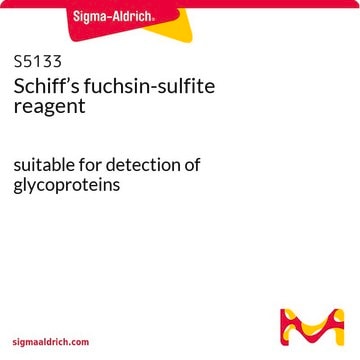All Photos(2)
About This Item
UNSPSC Code:
12352106
NACRES:
NA.47
grade:
for analytical purposes
form:
solution
Recommended Products
grade
for analytical purposes
form
solution
shelf life
Expiry date on the label
IVD
for in vitro diagnostic use
pH
<2.0
application(s)
hematology
histology
shipped in
wet ice
storage temp.
2-8°C
Application
Intended for use in Sigma Periodic Acid Staining Procedure, 395. Kit is intended for use with blood, bone marrow, tissue touch preparations or routine tissue sections.
Components
Pararosaniline, 1% and sodium metabisulfate, 4%, in hydrochloric acid, 0.25 mol/L
Other Notes
Use Sigma reagent S5133 for staining glycoproteins in polyacrylamide gels.
Signal Word
Danger
Hazard Statements
Precautionary Statements
Hazard Classifications
Carc. 1B - Eye Dam. 1 - Met. Corr. 1
Storage Class Code
6.1D - Non-combustible acute toxic Cat.3 / toxic hazardous materials or hazardous materials causing chronic effects
WGK
WGK 3
Flash Point(F)
Not applicable
Flash Point(C)
Not applicable
Choose from one of the most recent versions:
Certificates of Analysis (COA)
Lot/Batch Number
Don't see the Right Version?
If you require a particular version, you can look up a specific certificate by the Lot or Batch number.
Already Own This Product?
Find documentation for the products that you have recently purchased in the Document Library.
Customers Also Viewed
Rüdiger Braun et al.
Clinical cancer research : an official journal of the American Association for Cancer Research, 26(13), 3468-3480 (2020-04-08)
The standard treatment of patients with locally advanced rectal cancer consists of preoperative chemoradiotherapy (CRT) followed by surgery. However, the response of individual tumors to CRT is extremely diverse, presenting a clinical dilemma. This broad variability in treatment response is
Yan-Yan Song et al.
Oncology letters, 8(1), 431-437 (2014-06-25)
Vasculogenic mimicry (VM) formation is important for invasion and metastasis of tumor cells in gastric adenocarcinoma (GAC). The present study aimed to investigate the association between signal transducer and activator of transcription-3 (STAT3), phosphor-STAT3 (p-STAT3), hypoxia-inducible factor-1α (HIF-1α) and VM
Naser Mobarra et al.
International journal of hematology-oncology and stem cell research, 8(4), 20-29 (2015-03-17)
The use of stem cells is considered as an appropriate source in cell therapy and tissue engineering. Differentiation of human induced Pluripotent Stem Cells (hiPSCs) to Hepatocyte-like Cells (HLCs) on mouse embryonic fibroblasts (MEFs) feeders is confronted with several problems
Haoshen Shi et al.
Acta neuropathologica communications, 8(1), 202-202 (2020-11-25)
Extensive effort has been made studying retinal pathology in Alzheimer's disease (AD) to improve early noninvasive diagnosis and treatment. Particularly relevant are vascular changes, which appear prominent in early brain pathogenesis and could predict cognitive decline. Recently, we identified platelet-derived
Guillaume Pelletier et al.
Journal of applied toxicology : JAT, 40(5), 600-618 (2019-12-31)
Tris(2-ethylhexyl) phosphate (TEHP, CAS no. 78-42-2) is a plasticizer and a flame retardant, while di(2-ethylhexyl) phosphoric acid (DEHPA, CAS no. 298-07-7) is an oil additive and extraction solvent. Publicly-available information on repeated exposure to these two related organophosphate compounds is
Our team of scientists has experience in all areas of research including Life Science, Material Science, Chemical Synthesis, Chromatography, Analytical and many others.
Contact Technical Service











